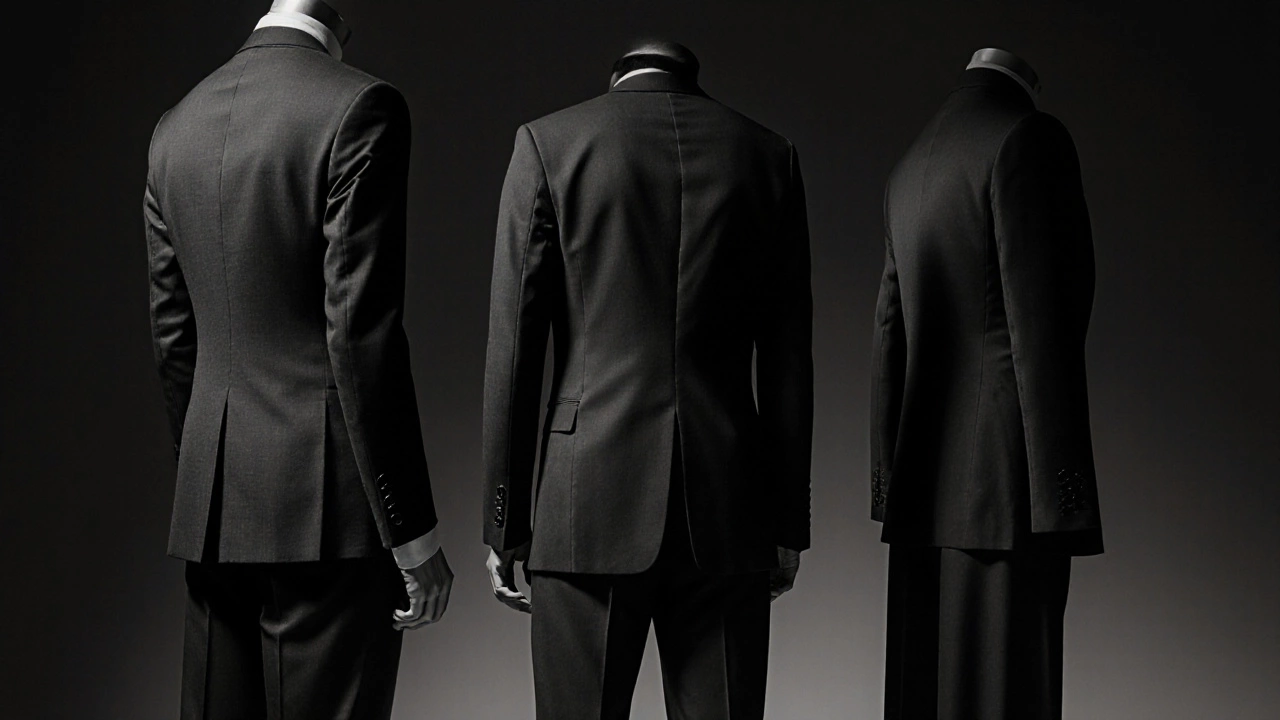Should a Suit Be Tight or Loose? The Perfect Fit Guide for Men

- Cleo Fairchild
- 3 November 2025
- 0 Comments
Suit Fit Checker
Check Your Suit Fit
Answer these 5 questions based on your suit's physical fit. This will help identify if you need alterations.
Answer the questions above to get your result.
Too tight and you look like you’re trying to burst out of your clothes. Too loose and you look like you borrowed your dad’s suit from 1998. The truth? A suit shouldn’t be tight or loose-it should be just right.
What a well-fitting suit actually feels like
A suit that fits properly doesn’t pull. It doesn’t sag. It doesn’t bunch up when you sit down. It moves with you, like a second skin that just happens to be tailored by a professional. The shoulders should sit exactly where your natural shoulder ends-no fabric hanging over, no gaps at the collar. If you can’t raise your arms without the jacket lifting up too much, it’s too tight. If the sleeves hang down past your wrist bone by more than half an inch, it’s too loose.The jacket should close comfortably without straining. Button it. Now take a deep breath. If you feel any resistance, if the buttons are pulling or the lapels are flaring open, the chest is too tight. A good fit lets you breathe without looking like you’re in a straitjacket. The fabric should lie flat across your torso, not ripple or pucker.
Why fit matters more than size
Size labels on suits are meaningless. A size 40 in one brand might be a size 38 in another. Even within the same brand, cuts change every season. That’s why you never buy a suit based on the tag. You buy it based on how it looks on your body.Think of it like shoes. You don’t wear a size 10 just because it says so on the box. You try them on. You walk. You see if your toes have room. Suits are the same. A man who’s 5’10” and 170 lbs might wear a 40R in one brand and a 38R in another. The only thing that matters is whether the jacket hugs your frame without squeezing it.
Most off-the-rack suits are cut for a standard build-broad shoulders, narrow waist. If your body doesn’t match that, you’ll need alterations. That’s not a flaw in you. It’s a flaw in mass production.
The three zones that matter: shoulders, waist, sleeves
There are three areas where fit makes or breaks a suit: shoulders, waist, and sleeves. Get these right, and the rest follows.- Shoulders: The seam of the jacket should sit exactly on the edge of your shoulder bone. If it’s even half an inch too far in, your arms will feel restricted. If it’s too far out, the jacket looks sloppy. This is the one thing you can’t fix easily-so get it right from the start.
- Waist: A suit should taper slightly at the waist, but not so much that it looks like a corset. You should be able to slide your hand between the jacket and your stomach. If you can’t, it’s too tight. If there’s a noticeable gap or excess fabric pooling, it’s too loose.
- Sleeves: The jacket sleeve should end at the base of your thumb, where your hand meets your wrist. Your shirt cuff should show about a quarter to half an inch beyond the suit sleeve. Too short? You look like you’re wearing a child’s suit. Too long? You look like you’re hiding your hands.

What happens when you wear a suit that’s too tight
A suit that’s too tight doesn’t just look bad-it feels bad. And it shows. When you sit down, the fabric stretches across your back and thighs. You get that unflattering horizontal line across your lower back. Your buttons strain. Your sleeves tighten around your forearms. You feel like you’re being squeezed every time you move.It’s worse in photos. In group shots, you stand out-not because you look sharp, but because you look uncomfortable. People notice. Even if they can’t say why, they sense something’s off. That’s the power of fit. It’s not about looking expensive. It’s about looking at ease.
And then there’s the health side. Tight suits restrict circulation. They can cause nerve compression in the arms, especially if you’re wearing one all day. I’ve seen men come into tailors with numb fingers after wearing a tight suit for a 12-hour meeting. That’s not fashion. That’s a warning sign.
What happens when you wear a suit that’s too loose
A suit that’s too loose looks like you’re trying to hide. The jacket hangs like a tent. The trousers pool around your ankles. The lapels flop open when you walk. It’s the opposite problem of tightness, but just as damaging to your image.Loose suits make you look younger than you are-or older. If you’re in your 30s and your suit swallows you whole, people assume you’re either still in college or haven’t updated your wardrobe since the 2000s. Neither is a good look.
And here’s the thing: loose suits are often cheaper. They’re made with extra fabric to fit a wider range of body types. But that’s not a bargain. It’s a waste of money. You pay for a suit that doesn’t flatter you. You pay for a suit that needs to be altered anyway. You might as well buy a tailored one from the start.
How to tell if your suit needs tailoring
You don’t need to be a tailor to spot a bad fit. Here’s your quick checklist:- Can you pinch more than an inch of fabric at the side seams? If yes, it’s too loose.
- Does the jacket gap when you button it? If yes, the chest is too big.
- Do the sleeves cover your knuckles? If yes, they’re too long.
- When you sit, does the jacket pull tight across your back? If yes, the shoulders or back are too tight.
- Do your trousers have horizontal wrinkles across the seat? If yes, they’re too baggy.
If even one of these is true, you need alterations. And no, you don’t need to spend £300 on a full custom suit. A good tailor can fix the sleeves, waist, and trouser length for under £50. That’s less than the cost of a decent shirt.

When to invest in a custom suit
If you wear a suit more than once a month, it’s worth investing in a custom or made-to-measure suit. Off-the-rack suits are designed for averages. Your body isn’t average. You have a unique shoulder slope, a different torso length, maybe one hip higher than the other.Custom suits start at around £500 in the UK. That’s not cheap. But think of it this way: a well-fitting suit lasts 10 years. A cheap, ill-fitting one lasts 2. You’ll buy three cheap suits in that time. One good one saves you money.
And the difference is visible. At a job interview, in a boardroom, at a wedding-you’ll stand out for the right reasons. People will notice your confidence, not your clothes.
What to do if you’re between sizes
Most men fall between sizes. You’re a 40 in the chest but a 38 in the waist. That’s normal. Don’t force yourself into a size that fits your chest and then suffer with baggy pants. Get the jacket that fits your shoulders and chest. Then get the trousers altered to fit your waist. Tailors do this every day.Same with sleeves. If your arms are long but your torso is short, buy a long-sleeve jacket and have the body taken in. It’s not a compromise. It’s smart shopping.
Never settle for a suit that’s close. Close is the enemy of great.
Final tip: Try it on with the right shoes and shirt
You wouldn’t try on a suit with bare feet and a T-shirt. So why do it? Always wear the same shoes you plan to wear with the suit. The height changes how the trousers break. Wear the same shirt you’ll pair with it. A thick cotton shirt needs more room than a thin dress shirt.And always stand up, sit down, and walk around the store. Do a mock handshake. Bend over like you’re tying your shoe. If it feels off then, it’ll feel worse in real life.
Should a suit jacket be tight around the chest?
No. A suit jacket should allow you to breathe comfortably when buttoned. You should be able to slide your hand flat between the jacket and your shirt without pulling. If the fabric stretches or the buttons strain, it’s too tight. The ideal fit lets the jacket lie flat without wrinkling.
Is it better to buy a suit too big or too small?
Always buy slightly bigger. A suit that’s too big can be taken in-easily and cheaply. A suit that’s too small can’t be made larger without ruining the structure. Shoulder width, sleeve length, and chest width are nearly impossible to alter upward. Tailoring works best when reducing size, not expanding it.
How much should suit pants sag?
They shouldn’t sag at all. Suit trousers should sit at your natural waist, not your hips. There should be a clean, slight break at the top of your shoe-no more than half an inch of fabric pooling. If the fabric is bunched or wrinkled across the seat, the pants are too loose or too long.
Can you wear a suit without tailoring?
You can, but you shouldn’t. Off-the-rack suits are designed for an average body, and very few men fit that average. Even minor adjustments-shortening sleeves, taking in the waist, adjusting trouser length-make a dramatic difference. Skipping tailoring is like buying shoes two sizes too big and calling it a day.
How do I know if my suit shoulders fit?
Stand straight in front of a mirror. The seam of the jacket should line up exactly with the end of your shoulder bone. If the seam hangs over your shoulder, it’s too wide. If it sits inward toward your neck, it’s too narrow. This is the most important fit point-if the shoulders are wrong, nothing else will look right.


